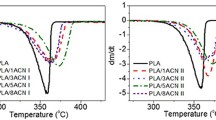Abstract
Cellulose is a renewable, sustainable, and high available biopolymer; their common form is the type-I polymorph. However, polymorphic changes are associated with different properties and a wide range of applications. In this study, we proposed a new method to prepare polymorphic cellulose nanostructures (CNSs): first, the CNS were isolated, and then the polymorphs were converted. CNS-I (type-I), CNS-II (type-II), and CNS-III (type-III) were successfully obtained, and the structure, crystallinity, superficial characteristic, morphology, and thermal stability were evaluated. The results showed that CNS-II and CNS-III are more amorphous than CNS-I due to the strong reagents used for the polymorphic conversion, which results in a swelling, increased chain spacing, and structural disorganization. This effectively changed the morphology of the CNS, from cellulose nanocrystals from irregular quasi-spherical nanoparticles. The proposed method allows a wide range of applications, from package and nanocomposites with CNS-I due to its high crystallinity and crystal morphology, to drug carrier, food thickener and biomedical products for CNS-II and CNS-III due to its quasi-spherical shape and more amorphous structure.
Graphic Abstract








Similar content being viewed by others
References
Kunaver M, Anžlovar A, Žagar E (2016) The fast and effective isolation of nanocellulose from selected cellulosic feedstocks. Carbohydr Polym 148:251–258. https://doi.org/10.1016/j.carbpol.2016.04.076
Corcelli F, Ripa M, Ulgiati S (2018) Efficiency and sustainability indicators for papermaking from virgin pulp—an emergy-based case study. Resour Conserv Recycl 131:313–328. https://doi.org/10.1016/j.resconrec.2017.11.028
da Silva CG, Kano FS, Rosa DS (2019) Lignocellulosic nanofiber from eucalyptus waste by a green process and their influence in bionanocomposites. Waste Biomass Valoriz.https://doi.org/10.1007/s12649-019-00610-3
Dufresne A (2017) Nanocellulose: from nature to high performance tailored materials, 2nd ed. De Gruyter, Berlin
Mahmud MM, Perveen A, Jahan RA et al (2019) Preparation of different polymorphs of cellulose from different acid hydrolysis medium. Int J Biol Macromol 130:969–976. https://doi.org/10.1016/j.ijbiomac.2019.03.027
Newman RH (2008) Simulation of X-ray diffractograms relevant to the purported polymorphs cellulose IVI and IVII. Cellulose 15:769–778. https://doi.org/10.1007/s10570-008-9225-5
Arvidsson R, Nguyen D, Svanström M (2015) Life cycle assessment of cellulose nanofibrils production by mechanical treatment and two different pretreatment processes. Environ Sci Technol 49:6881–6890. https://doi.org/10.1021/acs.est.5b00888
Malladi R, Nagalakshmaiah M, Robert M, Elkoun S (2018) Importance of agriculture and industrial waste in the field of nano cellulose and its recent industrial developments: a review. ACS Sustain Chem Eng.https://doi.org/10.1021/acssuschemeng.7b03437
Sánchez R, Espinosa E, Domínguez-Robles J et al (2016) Isolation and characterization of lignocellulose nanofibers from different wheat straw pulps. Int J Biol Macromol 92:1025–1033
De Souza AG, Kano FS, Bonvent JJ, Rosa DS (2017) Cellulose nanostructures obtained from waste paper industry: a comparison of acid and mechanical isolation methods. Mater Res 20:1–6
Gong J, Mo L, Li J (2018) A comparative study on the preparation and characterization of cellulose nanocrystals with various polymorphs. Carbohydr Polym 195:18–28. https://doi.org/10.1016/j.carbpol.2018.04.039
Naduparambath S, Jinitha TV, Vakyath S et al (2018) Isolation and characterisation of cellulose nanocrystals from sago seed shells. Carbohydr Polym 180:13–20. https://doi.org/10.1016/j.carbpol.2017.09.088
SaifulAzry SOA, Chuah TG, Paridah MT et al (2017) Effects of polymorph transformation via mercerisation on microcrystalline cellulose fibres and isolation of nanocrystalline cellulose fibres. Pertanika J Sci Technol 25:1275–1290
Sèbe G, Ham-Pichavant F, Ibarboure E et al (2012) Supramolecular structure characterization of cellulose II nanowhiskers produced by acid hydrolysis of cellulose I substrates. Biomacromolecules 13:570–578. https://doi.org/10.1021/bm201777j
Ciolacu D, Ciolacu F, Popa VI (2011) Blowoff scaling of bluff body stabilized flames. Cellul Chem Technol 45:13–21
Isogai A, Usuda M (1990) Crystallinity indexes of cellulosic materials. Sen’i Gakkaishi 46:324–329. https://doi.org/10.2115/fiber.46.8_324
Segal L, Creely JJ, Martin AE, Conrad CM (1959) An empirical method for estimating the degree of crystallinity of native cellulose using the X-ray diffractometer. Text Res J 29:786–794. https://doi.org/10.1177/004051755902901003
Mendes CVT, Cruz CHG, Reis DFN et al (2016) Integrated bioconversion of pulp and paper primary sludge to second generation bioethanol using Saccharomyces cerevisiae ATCC 26602. Bioresour Technol 220:161–167. https://doi.org/10.1016/j.biortech.2016.07.140
Yue Y, Han J, Han G et al (2015) Cellulose fibers isolated from energy cane bagasse using alkaline and sodium chlorite treatments: structural, chemical and thermal properties. Ind Crops Prod 76:355–363. https://doi.org/10.1016/j.indcrop.2015.07.006
Kim SH, Lee CM, Kafle K (2013) Characterization of crystalline cellulose in biomass: basic principles, applications, and limitations of XRD, NMR, IR, Raman, and SFG. Korean J Chem Eng 30:2127–2141. https://doi.org/10.1007/s11814-013-0162-0
Poletto M, Júnior HLO, Zattera AJ (2014) Native cellulose: structure, characterization and thermal properties. Materials (Basel) 7:6105–6119. https://doi.org/10.3390/ma7096105
García A, Labidi J, Belgacem MN, Bras J (2017) The nanocellulose biorefinery: woody versus herbaceous agricultural wastes for NCC production. Cellulose 24:693–704. https://doi.org/10.1007/s10570-016-1144-2
Nelson ML, O’Connor RT (1964) Relation of certain infrared bands to cellulose crystallinity and crystal lattice type. Part II. A new infrared ratio for estimation of crystallinity in celluloses I and II. J Appl Polym Sci 8:1325–1341. https://doi.org/10.1002/app.1964.070080323
Qin L, Li WC, Zhu JQ et al (2015) Ethylenediamine pretreatment changes cellulose allomorph and lignin structure of lignocellulose at ambient pressure. Biotechnol Biofuels 8:1–15. https://doi.org/10.1186/s13068-015-0359-z
Sawada D, Hanson L, Wada M et al (2014) The initial structure of cellulose during ammonia pretreatment. Cellulose 21:1117–1126. https://doi.org/10.1007/s10570-014-0218-2
Li X, Li J, Gong J et al (2018) Cellulose nanocrystals (CNCs) with different crystalline allomorph for oil in water Pickering emulsions. Carbohydr Polym 183:303–310. https://doi.org/10.1016/j.carbpol.2017.12.085
O’Sullvian AC (1997) Cellulose: the structure slowly unravels. Cellulose 4:173–207
Acknowledgements
The authors thank the financial support provided by FAPESP (2018/11277-7, 22035-4 and 2018/25239-0), CNPq, CAPES, NSF-CREST #1735971, and the Multiuser Experimental Center of the Federal University of ABC (CEM-UFABC).
Author information
Authors and Affiliations
Corresponding author
Additional information
Publisher's Note
Springer Nature remains neutral with regard to jurisdictional claims in published maps and institutional affiliations.
Electronic supplementary material
Below is the link to the electronic supplementary material.
Rights and permissions
About this article
Cite this article
de Souza, A.G., Junqueira, M.T., de Lima, G.F. et al. A New Proposal of Preparation of Different Polymorphs of Nanocellulose from Eucalyptus citriodora. J Polym Environ 28, 1150–1159 (2020). https://doi.org/10.1007/s10924-020-01672-4
Published:
Issue Date:
DOI: https://doi.org/10.1007/s10924-020-01672-4




